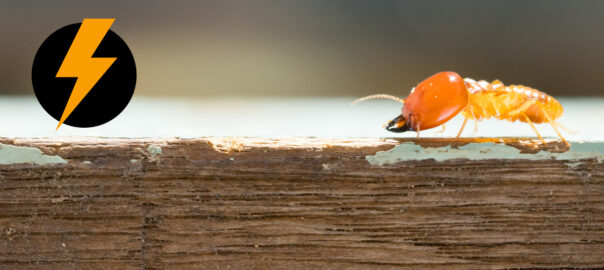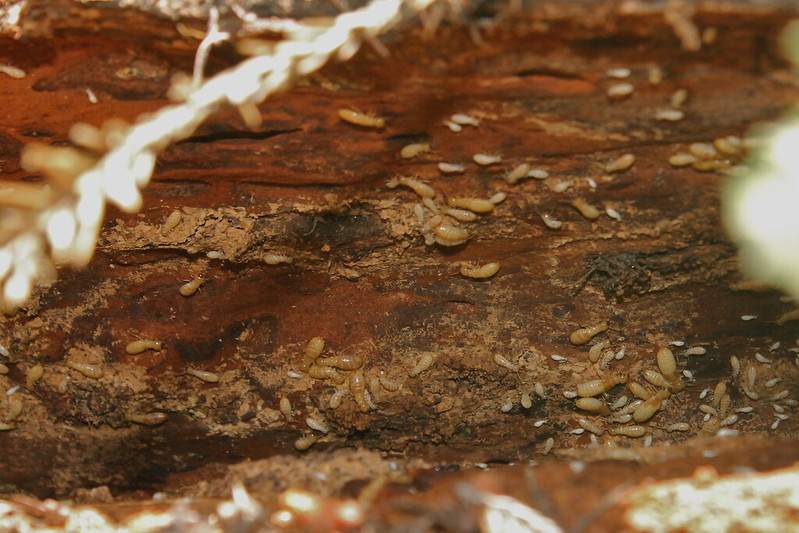Pet-Friendly Pest Control
- (541) 636-0146
- Schedule Service

The thought of termites can make your skin crawl, especially if you think about them invading your home. But are termites in Oregon a serious problem?
Yes. Because of the damp, humid spring weather in Oregon, termites are a common pest. They love the weather conditions in the Pacific Northwest. Frequent rains can cause excess moisture in homes, which they find extremely inviting. Here’s what you need to know about termites in Oregon and how you can prevent an invasion.
There are over two thousand different species of termites, with over forty species in the United States alone. Termites are known as silent destroyers since they may be secretly hiding and thriving in your home without any immediate signs of damage. They may be silent, but they are costly. These wood-munching pests cause billions of dollars of damage each year in the States.

There are four types of termites, but the most common in Oregon are the Pacific dampwood termite and the Western Subterranean termite. While each species thrives in different climates and eats different food sources, they all need four things to survive (which all homes provide):
These elusive insects are native to the Western part of the United States, making Oregon one of their natural habitats. They thrive in the moist Pacific Northwest climate, which provides ideal conditions for them.
The Western Subterranean termite has a discreet appearance. It’s small, measuring about 1/8 to 3/8 inches in length, and is creamy white to pale brown in color, with a soft body.
These termites are notorious for their wood-devouring tendencies. They feed on cellulose, a component found in wood and plant materials. Their relentless appetite for wood makes them a significant threat to homes.
Western Subterranean termite groups have a simple and effective mating ritual. They swarm in late winter or early spring, during which winged reproductive termites emerge from their colonies to mate. After mating, they shed their wings and search for suitable locations to establish new colonies.
Subterranean termites live in large colonies with various castes, including workers, soldiers, and reproductives (kings and queens). A single colony can contain hundreds of thousands of termites.
If you suspect a Subterranean termite infestation, you need to act fast, whether through DIY solutions or professional methods:
Western Subterranean termites are the most destructive termites in Oregon, causing expensive damage to homes and buildings by destroying foundations, wooden support beams, plastic plumbing pipes, subflooring, and insulation. These tiny terrors can be even harder to discover since they typically live underground or near the base of homes. Preventive measures, DIY methods, and professional help can ensure your home remains termite-free.
Dampwood termites may not be as notorious as their Subterranean cousins, but they also pose a threat to homes, especially in damp regions like Oregon. Let’s dive into their world, from their appearance to their habits, and how to keep them from making your home their own.
Dampwood termites have distinctive characteristics. The Pacific dampwood termite is the largest of the common Northwest termite species. It is larger than a Subterranean termite, with an adult dampwood termite reaching up to one inch in length. A dampwood termite’s color varies from light to dark brown, with a robust cylindrical body.
Dampwood termites, as their name suggests, primarily feed on moist wood. They are drawn to wood with high moisture content, often resulting from contact with the ground or exposure to leaks. Unlike many other termite species, dampwood termites don’t frequently infest buildings, showing a preference for more natural wood sources.
Dampwood termite species have a straightforward mating ritual. Typically, swarms of winged reproductive termites emerge from their colonies during the spring or summer. After mating, they shed their wings and seek out suitable locations to establish new colonies.
Dampwood termite colonies are relatively small compared to those of Subterranean termites. They typically consist of a few hundred to a few thousand termites, often residing in decaying wood.
Unlike other termites, these pests don’t need contact with soil to make their way into structures. Dampwood termite entry points differ from those of Subterranean termites:
Damp wood termites can cause significant damage, especially when you don’t reach out to a pest control professional experienced in termite control. Understanding their appearance, habits, and how to protect your home from them is essential. By addressing moisture issues, regularly inspecting wood, and seeking professional termite control when needed, you can keep your home safe from these moisture-loving invaders. Don’t let damp wood termites turn your home into a waterlogged buffet!
If you suspect dampwood-termite activity, swift action is crucial. If you plan to go the DIY route, remove and replace any infested wood to prevent the colony from expanding. Continue moisture-control efforts to discourage further infestation. If you need professional methods, consult a pest control professional to assess the extent of infestation and determine appropriate treatment, which may involve using termiticides or fumigation.
Termites are sneaky little insects that can be difficult to detect if you don’t know what to look for. However, there are usually telltale signs that let you know you may have underlying termite activity:
If you notice these warning signs, it’s time to call a professional pest control company immediately. While Bug Zappers Pest Control doesn’t treat for termites, we do offer pest control services that can help spot issues early, potentially saving you thousands of dollars worth of termite damage.
Termite treatment should always be left to professional pest control companies, but you can take these steps to prevent termite problems.
Your home is your sanctuary, and you want to keep it pest-free. The best offense is a good defense against termite damage. Our professionally trained, knowledgeable team at Bug Zapper Pest Control is ready to be your defense. Contact us today!
Not sure when it’s time to call in the pros? Here are six tips to let you know it’s time to pick up the phone. Learn more about how we can help you with termite control.
Call or text 541-636-1146 for a pest inspection today!



